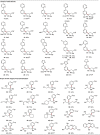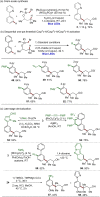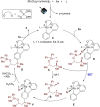Photo-Induced Ruthenium-Catalyzed Double Remote C(sp2 )-H / C(sp3 )-H Functionalizations by Radical Relay
- PMID: 35527721
- PMCID: PMC9401009
- DOI: 10.1002/anie.202205562
Photo-Induced Ruthenium-Catalyzed Double Remote C(sp2 )-H / C(sp3 )-H Functionalizations by Radical Relay
Abstract
Distal C(sp2 )-H and C(sp3 )-H functionalizations have recently emerged as step-economical tools for molecular synthesis. However, while the C(sp2 )-C(sp3 ) construction is of fundamental importance, its formation through double remote C(sp2 )-H/C(sp3 )-H activation has proven elusive. By merging the ruthenium-catalyzed meta-C(sp2 )-H functionalization with an aliphatic hydrogen atom transfer (HAT) process, we, herein, describe the catalyzed twofold remote C(sp2 )-H/C(sp3 )-H functionalizations via photo-induced ruthenium-mediated radical relay. Thus, meta-C(sp2 )-H arene bonds and remote C(sp3 )-H alkane bonds were activated by a single catalyst in a single operation. This process was accomplished at room temperature by visible light-notably without exogenous photocatalysts. Experimental and computational theory studies uncovered a manifold comprising ortho-C-H activation, single-electron-transfer (SET), 1,n-HAT (n=5-7) and σ-activation by means of a single ruthenium(II) catalyst.
Keywords: C−H Activation; Hydrogen Atom Transfer; Photocatalysis; Ruthenium; meta-Functionalization.
© 2022 The Authors. Angewandte Chemie International Edition published by Wiley-VCH GmbH.
Conflict of interest statement
The authors declare no conflict of interest.
Figures






Similar articles
-
Ruthenium-Catalyzed Remote Difunctionalization of Nonactivated Alkenes for Double meta-C(sp2 )-H/C-6(sp3 )-H Functionalization.Angew Chem Int Ed Engl. 2023 Jun 26;62(26):e202301168. doi: 10.1002/anie.202301168. Epub 2023 May 15. Angew Chem Int Ed Engl. 2023. PMID: 37085460
-
Iodoarene-directed photoredox β-C(sp3)-H arylation of 1-(o-iodoaryl)alkan-1-ones with cyanoarenes via halogen atom transfer and hydrogen atom transfer.Chem Sci. 2024 Mar 26;15(17):6522-6529. doi: 10.1039/d3sc06637a. eCollection 2024 May 1. Chem Sci. 2024. PMID: 38699280 Free PMC article.
-
Photo-Induced Ruthenium-Catalyzed C-H Arylations at Ambient Temperature.Angew Chem Int Ed Engl. 2020 Oct 5;59(41):18103-18109. doi: 10.1002/anie.202003035. Epub 2020 Aug 17. Angew Chem Int Ed Engl. 2020. PMID: 32662573 Free PMC article.
-
Photocatalyzed Enantioselective Functionalization of C(sp3)-H Bonds.J Am Chem Soc. 2024 Jan 17;146(2):1209-1223. doi: 10.1021/jacs.3c06169. Epub 2024 Jan 3. J Am Chem Soc. 2024. PMID: 38170467 Review.
-
N-Centered Radical Directed Remote C-H Bond Functionalization via Hydrogen Atom Transfer.Chem Asian J. 2020 Mar 16;15(6):651-672. doi: 10.1002/asia.201901744. Epub 2020 Feb 18. Chem Asian J. 2020. PMID: 32011095 Review.
Cited by
-
Visible light-induced ruthenium(ii)-catalyzed hydroarylation of unactivated olefins.Chem Sci. 2024 Oct 23;15(45):19037-43. doi: 10.1039/d4sc06005a. Online ahead of print. Chem Sci. 2024. PMID: 39479157 Free PMC article.
-
Biomimetic Catalytic Remote Desaturation of Aliphatic Alcohols.Org Lett. 2025 Jan 10;27(1):30-35. doi: 10.1021/acs.orglett.4c03623. Epub 2024 Dec 23. Org Lett. 2025. PMID: 39714251 Free PMC article.
-
Rapid and scalable ruthenium catalyzed meta-C-H alkylation enabled by resonant acoustic mixing.Commun Chem. 2024 Dec 18;7(1):295. doi: 10.1038/s42004-024-01390-1. Commun Chem. 2024. PMID: 39695309 Free PMC article.
-
meta-C-H functionalization of phenylethyl and benzylic alcohol derivatives via Pd/NBE relay catalysis.Chem Sci. 2024 Sep 4;15(38):15819-24. doi: 10.1039/d4sc03802a. Online ahead of print. Chem Sci. 2024. PMID: 39268204 Free PMC article.
-
Electroreductive room-temperature C-H activations with RuCl3·nH2O precatalyst via cathodic ruthenium(iii/ii) manifold.Chem Sci. 2025 Jun 27;16(29):13468-13476. doi: 10.1039/d5sc02780b. eCollection 2025 Jul 23. Chem Sci. 2025. PMID: 40584230 Free PMC article.
References
-
- For selected reviews of C−H activation, see:
-
- Guillemard L., Kaplaneris N., Ackermann L., Johansson M., Nat. Rev. Chem. 2021, 5, 522–545; - PubMed
-
- Prabagar B., Yang Y., Shi Z., Chem. Soc. Rev. 2021, 38, 3242–3272; - PubMed
-
- Rogge T., Kaplaneris N., Chatani N., Kim J., Chang S., Punji B., Schafer L. L., Musaev D. G., Wencel-Delord J., Roberts C. A., Sarpong R., Wilson Z. E., Brimble M. A., Johansson M. J., Ackermann L., Nat. Rev. Methods Primer 2021, 1, 43;
-
- Gandeepan P., Müller T., Zell D., Cera G., Warratz S., Ackermann L., Chem. Rev. 2019, 119, 2192–2452; - PubMed
Grants and funding
LinkOut - more resources
Full Text Sources

